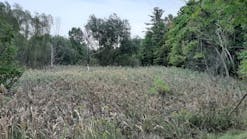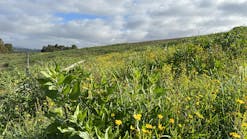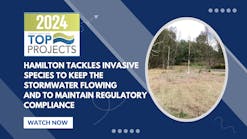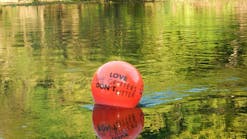The Fractal Nature of Erosion: Mathematics, Chaos, and the Real World
Mathematical WondersIt is important to understand the basics of fractal mathematics before delving into how fractals are used to model landscapes. We’ll start at the beginning and work our way up to nonlinear fractals, fractal landscapes, and erosion prediction.One could spend an entire summer contemplating the wonder of one of the first fractals, the von Koch snowflake. Discovered by mathematician Helge von Koch in 1904, this snowflake is a prime example of the fractal geometry related to the problem of measuring Great Britain’s coastline.
Figure 4. The famous Mandelbrot set takes seconds to generate and a lifetime to master. Here we have (a) the original set, (b) 4x magnification, and (c) 8x magnification. No matter how many times we zoom in, we will always see this level complexity.The most celebrated nonlinear fractals are the Julia and Mandelbrot sets. As with the Sierpinski triangle, we can arbitrarily zoom in on these fantastic fractals and see amazing structure at any level (Figure 4). But unlike Sierpinski triangles with their identical self-similarity, nonlinear fractals do not reproduce themselves exactly upon magnification. Each closer look provides an image that is totally new. Adjusting a few initial parameters leads to drastic changes in the final fractal, which is why fractals are so much fun to toy with on idle afternoons. Nonlinear fractals are far more reasonable for modeling geological and living systems. When was the last time you saw a perfect triangle in nature?On the other hand, when was the last time you saw something as bizarre as the Mandelbrot set in nature? By increasing the complexity of fractals, we make a big step in modeling erosion. Nonlinear fractals are self-similar but not exactly the same under magnification. A single beach might resemble the entire coastline, but we cannot expect it to look exactly the same. Mandelbrot and others soon discovered how to use the new nonlinear mathematics to generate fractal surfaces.Fractal SurfacesWith the help of raw computing power, we can manipulate fractals to form impressive landscape images. Fractal landscapes are used in a variety of computer artwork, including movies. Unfortunately, the well-trained eye will quickly raise suspicion about the accurate simulation of real erosion by these fractals. The computer-rendered mountains rarely take erosive processes into account. Even so, fractal landscapes are an important step in unleashing fractal mathematics to the erosion community.The science of generating fractal landscapes is not as complicated as one would think, but the one major requirement is randomness. Fractal terrains start with-you guessed it-a triangle. Connecting the midpoints of a triangle forms four new triangles. Then the important step is to shift each midpoint out of the page a random distance. Now our shape no longer resembles anything like a triangle; it is three-dimensional and rough. Repeat this process in a fractal-like nature with the smaller and smaller morphed triangles, and the surface gets a rougher, rocky appearance. Add a computer-generated light source, and you end up with fractal mountains that look strikingly real (Figure 5).
www.fractalarts.comYonathan Shapir, Ph.D., approached the problem of fractals from a physical instead of mathematical perspective. He and his colleagues have successfully linked fractals to the physical erosion process. They’ve also verified their mathematical results experimentally. The group continued by using fractals to predict when a single critical point will erode through a surface. This groundbreaking research finally opens up fractals to practical use in erosion. Since the Rochester results are still in laboratory phases, the possibilities are wide open for the erosion and geology community to use new data on larger scales for the first time ever.The Rochester group began by examining the relationships between cyclical processes and erosion/deposition. Cyclical processes are, of course, found frequently in nature; just consider rainfall, ocean waves, spring runoff, and so on. The scientists found that cyclical erosion or deposition processes create fractal surfaces. After working out fractal equations analytically (equations and proofs), Shapir and his colleagues verified their results using numerical calculations. With a solid mathematical foundation in place, they turned to experimental methods. They began with computer simulations. Each data point consisted of 50-5,000 runs, and each run consisted of 500-10,000 cycle simulations to ensure statistical accuracy. The results of the computer simulations were exactly what the theory predicted: Cycles of erosion and deposition create a self-similar fractal surface. The final test was to see if physical surfaces display the fractal properties predicted by the theory. The research group used a silver solution deposited and eroded over several cycles. They examined the surface roughness with an atomic-force microscope at different phases, and sure enough, it had the predicted fractal properties. Observing fractal behavior within the laboratory deposition chamber is one thing, but what about on beaches? We know that the coastline is a fractal and that the high and low tides are cyclical processes. I asked Shapir about applying his research to beaches. “The formation of beaches under the cyclical low and high tides is a typical example of cyclical fractal growth,” he says. “Our theory could, in principle, turn into a predictive model. For that, we need as an input how the coast forms under high tide alone-in particular, the fractal properties-and under low-tide conditions alone. We will then be able to calculate how these two processes combine into a cyclical process and predict the fractal properties of the coast formed in this cyclical process.”Once Shapir’s group demonstrated experimental reliability of their mathematics, they combined fractals with a branch of math known as “extreme-value statistics” and went on to predict when a single point will erode through. Again, this research is still in its infancy; there is a plethora of research open to the erosion field based on these preliminary results. The Rochester group discovered that the extreme point of a surface is related to the surface roughness. This result is significant; it means that by examining solely surface roughness, you can predict when a point will erode to a given depth. Using similar methods, the scientists modeled erosion backward to determine what a surface looked like before it eroded. The next step in this novel research is to test the predictions experimentally.There are immediate applications for Shapir’s research. For instance, the fractal models can be used to figure out at what point the surface inside a battery will erode through. Other immediate applications include determining how long a steel pillar can support a bridge before it rusts and how long a container can hold an acid before it springs a leak. But even more important is the fact that a physical tie has been formed between fractal mathematics and the erosion process. What we have now is a gold mine of mathematics waiting to be extracted by geology and landscape architecture. The world of erosion is a strange one; chaotic forces carve the landscape with fractal patterns. Shapir himself notes, “Often things are not formed by a single process, but by a combination of growth and recession. What’s amazing is that so many growth and recession cycles can be described by just a few fractal solutions.” Not long ago, one could look at a horribly eroded surface and feel assured that math could never explain such a muddy mess. That is no longer the case; the math that stemmed out of infinity, chaos, and randomness has finally found its way to an appropriate application. Just as we borrow the mathematics of ellipses to predict and understand elliptic orbits of the planets, we will soon be able to borrow fractal mathematics to predict and understand the fractal nature of erosion.





